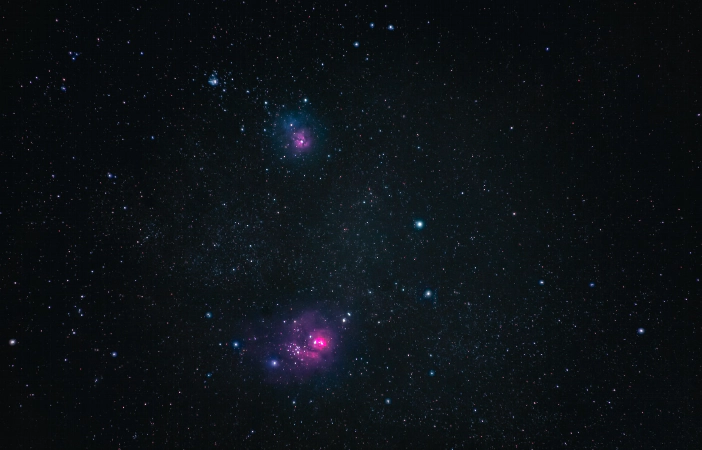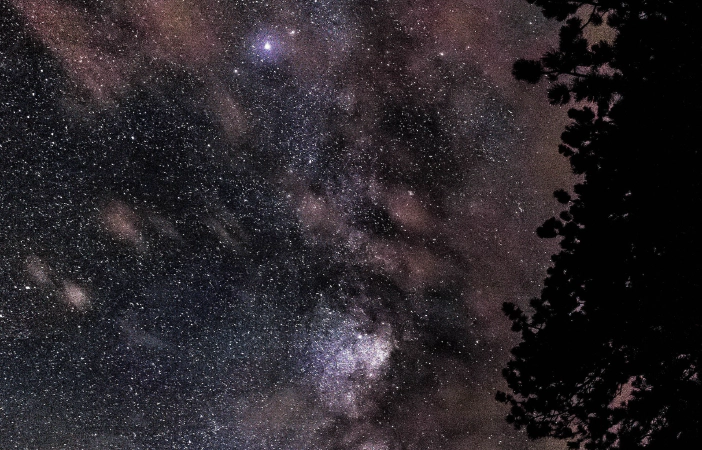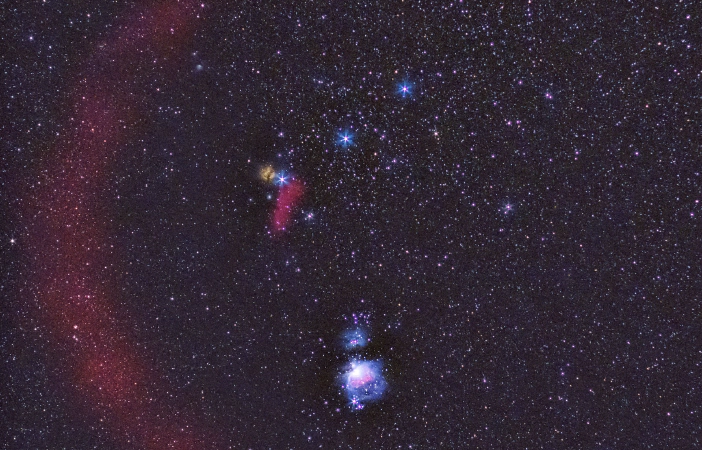
When it comes to the Orion Nebula, it’s hard not to be captivated. This celestial wonder has fascinated astronomers for generations, but it’s the amateur astronomers who have really put it on the map. But why? What is it about this nebula that draws amateur astronomers to it?
For starters, the Orion Nebula is easily visible to the naked eye. It’s right there, in plain sight, even for those who may not have access to telescopes or other equipment. And once you see it, you can’t help but be captivated by its visual appeal. The swirling clouds of gas and dust, the bright stars at its center, and the subtle variations in color — all of these elements come together to create a stunning work of art in the sky.
But it’s not just about the visual appeal. Amateur astronomers are drawn to the opportunities for discovery that the Orion Nebula provides. With its rich array of stars and unusual stellar formations, there’s always something new to learn or discover. And because it’s visible from both hemispheres, astronomers from all around the world have been able to contribute to our understanding of this fascinating nebula.
So how do amateur astronomers study the Orion Nebula? Many start with binoculars or telescopes, observing the nebula and its surrounding stars in detail. Others turn to photography, using specialized equipment to capture stunning images of the nebula and its surroundings. And still others use more sophisticated tools, like spectroscopy and polarimetry, to explore the nature of the nebula and its constituent parts.
Over the years, amateur astronomers have made a number of important contributions to our understanding of the Orion Nebula. They’ve helped identify young stars and planetary systems, monitored changes in the nebula over time, and even discovered new objects within the nebula itself.
As we look to the future, there’s no doubt that amateur astronomers will continue to play an important role in our understanding of the Orion Nebula and the wider universe. With new tools and technologies emerging all the time, the potential for discovery and exploration is greater than ever before.
A Brief Overview of The Orion Nebula

So, you want to know a bit more about the Orion Nebula? Well, buckle up, my friend. This celestial beauty is a stellar nursery of epic proportions, and not only that, it’s visible to the naked eye from certain locations. Let’s dive in and take a quick tour of its size, distance, age, and formation.
Size and Distance
When we think of the Orion Nebula, our minds may conjure up images of a massive, sprawling celestial body that dwarfs everything else in its path. And it’s true, the nebula is massive - measuring about 24 light-years across. But what’s perhaps more mind-boggling is just how far away it is from us here on Earth. The Orion Nebula is approximately 1,344 light-years away, which means that the light we see coming from it today actually began its journey over a thousand years ago.
Trying to wrap our heads around sizes and distances on this scale can be difficult, to say the least. But for amateur astronomers who are fascinated by the Orion Nebula and others like it, it’s all par for the course. When we stare up at the night sky, it’s easy to forget just how vast and complex the universe truly is. But even as we struggle to comprehend the sheer enormity of the Orion Nebula, we can’t help but be drawn in by its majesty and beauty. Whether we’re observing it through telescopes or simply gazing at it with the naked eye, the nebula never fails to captivate us. And as amateur astronomers continue to explore and study this fascinating celestial body, who knows what new discoveries and insights we might uncover about the mysteries of the universe?
Age and Formation
When looking up at the night sky, it can be easy to forget just how immense and complex our universe truly is. But the Orion Nebula serves as a stunning reminder of the beauty and mystery that exists beyond our planet. One fascinating aspect of the nebula is its age and formation.
Believed to have formed around two million years ago, the Orion Nebula is a relatively young object in astronomical terms. It is estimated that the nebula contains over a thousand young stars that were born from clouds of hydrogen gas. These stars are responsible for the nebula’s stunning glow, as the ultraviolet radiation they emit causes the surrounding gas to glow brightly.
But the formation of the Orion Nebula is not a one-time event, as new stars continue to form within the nebula. The turbulent gas clouds within the nebula collide and compress, eventually leading to the formation of new stars. This ongoing process makes the Orion Nebula a rich environment for studying the formation and evolution of stars.
Scientists have also used the Orion Nebula to study the “birth” of planetary systems. As new stars form, they are often surrounded by a disk of gas and dust. Over time, these disks can coalesce into planets. By studying the disk structures within the Orion Nebula, researchers have gained valuable insights into the early stages of planetary formation.
Overall, the age and formation of the Orion Nebula offer a fascinating glimpse into the ongoing processes that shape our universe. Its young age, ongoing star formation, and insights into planetary formation make it a rich environment for scientific inquiry.
How Amateurs Spotted the Nebula
How did a group of amateur astronomers make one of the most important discoveries in astronomy? It all started in the 17th century, when every astronomer of the time was looking at the night sky through the same lens. But the Orion Nebula was passed over time and time again because it was too faint to be seen by the naked eye.
It wasn’t until the 19th century that we really began to see the nebulosity of the Orion Nebula. But it wasn’t until the early 20th century that amateurs really began to take notice. A group of amateur astronomers from several different countries joined together to observe the nebula and began to notice something strange; they saw many small, bright points of light within the nebulosity.
Being amateurs, they didn’t have the resources to fully understand what they were seeing, but they knew it was important. They sent their observations to professional astronomers, who were able to study them in more detail. The professionals quickly realized that these tiny dots of light were actually newly forming stars within the Orion Nebula.
Without the work of these amateur astronomers, it is possible that this discovery could have taken decades longer. It goes to show that sometimes it takes a fresh set of eyes to see something truly important. So if you’re interested in astronomy, don’t be afraid to start observing! Who knows what you might discover.
Why The Orion Nebula Captivates Amateur Astronomers

Why The Orion Nebula Captivates Amateur Astronomers, you ask?
Let me tell you, my friend, there are plenty of reasons to be absolutely spellbound by this cosmic wonder. For starters, it’s visible to the naked eye - talk about a celestial showstopper!
And don’t even get me started on its visual appeal - with its billowing clouds of gas and dust, fiery stars, and stunning color palette, it’s like a psychedelic dreamscape come to life.
But the allure doesn’t end there - the Orion Nebula also offers endless opportunities for discovery, from identifying young stars and planetary systems to measuring and monitoring changes in the nebula over time.
So what are you waiting for? Grab your telescope (or binoculars, if you’re feeling frisky), and let’s take a closer look at this marvel of the cosmos.
Visible to the Naked Eye
Looking up at the night sky can be an awe-inspiring experience. The vastness and complexity of the cosmos can be overwhelming, but one thing is for certain - there’s a lot to see. The Orion Nebula is one of those things, and what’s great about it is that it’s visible to the naked eye. That’s right - you don’t need any special equipment to catch a glimpse of this celestial wonder.
Of course, you won’t be able to see all the intricate details that amateur astronomers can pick up with their telescopes, but you’ll definitely be able to appreciate its beauty. The nebula is visible as a faint blur in the sky, which is made up of mostly hydrogen gas and dust. It’s the brightest nebula in the sky and can be seen from almost anywhere in the world.
What’s exciting about being able to see the Orion Nebula without any special equipment is that it gives everyone the chance to connect with the universe. It’s a reminder that we’re part of something much bigger than ourselves, and that there’s always more to discover. Plus, just knowing that you’re looking at something that’s 1,344 light-years away is mind-blowing.
So, why not take a moment to look up at the night sky and see if you can spot the Orion Nebula? It might not look like much at first, but knowing what it is and how far away it is can make it all the more special. And who knows, maybe you’ll be inspired to pick up a pair of binoculars or a telescope and explore the cosmos even further.
The Nebula’s Visual Appeal
When it comes to the visual appeal of the Orion Nebula, amateur astronomers can’t help but be captivated. It’s a wonder of the night sky that has inspired countless people to take up stargazing, and for good reason. The sheer beauty of the nebula is undeniable, with its swirling clouds of gas and dust creating a stunning array of colors and patterns.
What makes the nebula so visually striking is its mix of hues, ranging from pale blues and greens to vibrant pinks and oranges. These colors are produced by different gases, such as hydrogen and oxygen, that are ionized by the radiation from nearby stars. In addition to the array of colors, the nebula also features dark patches, known as “dust lanes,” that provide dramatic contrast and depth to the scene.
Another aspect that adds to the visual appeal of the Orion Nebula is the phenomenon known as “Herbig-Haro objects.” These are jets of gas that shoot out from young stars, creating glowing, finger-like structures that extend out into the nebula. These jets can be seen in photographs of the nebula, and they give the impression of an energetic, dynamic environment that is rich with new stars being born.
Overall, the visual appeal of the Orion Nebula is what draws many amateur astronomers to it time and time again. It’s a stunning, awe-inspiring scene that reminds us of the beauty and complexity of the universe we live in.
Opportunities for Discovery
When it comes to exploring the wonders of the universe, the Orion Nebula presents amateurs with exciting opportunities for discovery. From peering through binoculars to advanced telescopes, the nebula’s immense size and visual appeal are a sight to behold for those with a passion for astronomy.
But it’s not just about the visual aspects. Amateurs have contributed significantly to our understanding of the Orion Nebula, identifying young stars and planetary systems, and measuring changes within the nebula over time. Their dedication and curiosity have led to groundbreaking discoveries in the field of astronomy and furthered our understanding of the universe.
Through astrophotography and monitoring changes within the nebula, amateurs have also played a vital role in observing and analyzing the evolution of the Orion Nebula. It’s a constant process of discovery and learning, and enthusiasts are always looking for new tools and techniques to better understand the mysteries of the cosmos.
The potential for citizen science projects in this area is immense, and amateur astronomers of all levels can contribute to our collective knowledge. From measuring the temperature of the nebula’s gas to identifying new planetary systems, there’s always an opportunity to make a meaningful contribution to the field of astronomy.
So what are you waiting for? Dive into the wonders of the Orion Nebula and uncover its secrets for yourself. The opportunities for discovery are endless, and the rewards are immeasurable.
How Amateur Astronomers Study The Orion Nebula

How do amateur astronomers get up close and personal with the magnificent Orion Nebula? Let’s take a deeper dive into the observational and photographic methods used by stargazing enthusiasts. From surveying the near-limitless expanse of space with binoculars to achieving stunning astrophotography, there are a multitude of ways amateur astronomers continue to contribute to the study of the Orion Nebula.
Observing with Binoculars and Telescopes
When it comes to observing the Orion Nebula, amateur astronomers have a few different options. Binoculars and telescopes are two of the most popular tools for observing celestial objects, including the nebula.
Binoculars are a great choice for beginner astronomers or those who want a more casual observing experience. They are lightweight and easy to use, and they provide a wider field of view than telescopes. With binoculars, observers can take in the entirety of the Orion Nebula and its surroundings, including other stars and galaxies in the area. For those who want a bit more magnification, there are also binoculars available with tripod mounts or who are able to be attached to a telescope mount.
Telescopes, on the other hand, offer more magnification and detail than binoculars. They allow observers to see the individual colors and shapes of the nebula’s various parts, including the bright central region and the surrounding wispy clouds of dust and gas. By adjusting various settings on their telescope or using different eyepieces, observers can enhance their view of the nebula and reveal new details. For those who are able to afford them, larger and more complex telescopes offer even more detailed views.
Of course, observing the Orion Nebula with binoculars or telescopes can only take an astronomer so far. To truly study the nebula and make significant discoveries, astronomers often turn to other tools such as photography, astrophotography, and other more specialized observational instruments. But for the casual observer or amateur astronomer, binoculars and telescopes offer a fun and rewarding way to explore the universe and gain a new appreciation of our place in it.
Photography and Astrophotography
When it comes to capturing the beauty of the Orion Nebula, photography and astrophotography have become some of the most popular methods among amateur astronomers. By using specialized cameras and equipment, astrophotographers are able to take stunning images of the nebula and its surroundings.
But it’s not just about taking pretty pictures - astrophotography actually has practical uses in studying the nebula. By using techniques such as long exposures and stacking multiple images, astrophotographers can reveal details and structures that may not be visible through traditional observation methods.
One of the challenges of astrophotography is properly capturing the colors of the nebula. Due to the low light levels, a process known as color balancing is necessary to accurately represent the hues of the nebula in the final image. This can be a complex and time-consuming process, but the results are often worth it.
But photography and astrophotography aren’t just about capturing the beauty of the nebula - they also provide a way for amateur astronomers to contribute to scientific research. By submitting their images to databases such as the American Association of Variable Star Observers or the International Dark-Sky Association, astrophotographers can help monitor changes and variations in the nebula over time.
So whether you’re a beginner or an experienced astrophotographer, capturing the beauty and mystery of the Orion Nebula through photography can be a rewarding and fascinating experience. And who knows - your images may even help contribute to our understanding of this incredible astronomical phenomenon.
Discoveries and Contributions Made by Amateur Astronomers
Amateur astronomers not only spotted the Orion Nebula, but they also made significant contributions to its study. One of their most notable achievements was the discovery of the Trapezium Cluster, a grouping of four stars at the center of the nebula. This cluster was first observed by Galileo in 1610 but was not fully understood until the 19th century.
In the 1880s, William Huggins and Jacobus Kapteyn used spectroscopy to study the Trapezium Cluster and discovered that it contained several different spectral classes of stars. This finding was significant because it provided evidence that stars form in clusters and can have varying properties.
Amateur astronomers also played a crucial role in the observation of variable stars in the Orion Nebula. These stars are called “T Tauri” stars, and they undergo significant changes in brightness over time. In the 1930s, amateur astronomer Sidney van den Bergh discovered a new type of T Tauri star in the Orion Nebula. This discovery helped astronomers to better understand the formation and evolution of stars.
Additionally, amateurs have contributed to the study of the Orion Nebula through their observations of planetary systems within the nebula. In 1983, amateur astronomer Tom Herbst discovered a protoplanetary disk around a young star in the Orion Nebula. This discovery was groundbreaking because it provided evidence for the formation of planets around other stars.
Identifying Young Stars and Planetary Systems
As an amateur astronomer, there’s nothing quite as exciting as spotting a young star or a planetary system. The idea that somewhere out there, a celestial body is taking shape and might be home to life is fascinating. But how do we identify these young stars and planetary systems?
First, we rely on our ability to measure and monitor changes in the nebula. By analyzing the light spectrum emitted from different areas of the nebula, we can identify the telltale signs of areas where young stars might be forming. We can also use high-resolution imaging to spot protoplanetary disks around these stars, which are indicative of a planetary system in the making.
But identifying a young star or a planetary system is just the beginning. We can also learn a lot about their properties and evolution over time. For example, by measuring the brightness and temperature of a young star, we can determine its mass and age. By studying the chemical composition of the protoplanetary disk, we can learn about the types of planets that might be forming.
One of the most exciting recent discoveries made by amateur astronomers was the identification of a young star surrounded by a disk of gas and dust that appears to be in the process of forming planets. In fact, the disk is believed to be only a few million years old, making it one of the youngest known exoplanetary systems. This discovery is an important step towards understanding the formation and evolution of planetary systems.
As the technology and techniques for observing the nebula continue to advance, we can expect to make even more exciting discoveries in the coming years. Who knows what new young stars and planetary systems we might uncover?
Measuring and Monitoring Changes in the Nebula
When it comes to studying the Orion Nebula, it’s not just about identifying young stars and planetary systems. Amateur astronomers have also made important contributions in measuring and monitoring changes in the nebula.
With advances in technology and equipment, astronomers can now track changes in the nebula over time with greater precision. They can measure the temperature and density of the gas clouds, as well as monitor the movement of stars and other objects within the nebula.
One recent development has been the use of spectroscopy to study the nebula in greater detail. By analyzing the light emitted by the gases and materials within the nebula, astronomers can learn more about their composition and properties.
Amateur astronomers also play a crucial role in monitoring any changes in the nebula’s brightness and structure. By regularly observing and recording their observations, they can help scientists to detect and understand any anomalies or fluctuations in the nebula, which could provide valuable insights into its behavior and evolution over time.
Overall, measuring and monitoring changes in the Orion Nebula is an important area of study for astronomers of all levels, from amateurs to professionals. By combining their observations and working together, they can help to build a more complete picture of this fascinating and beautiful astronomical feature.
